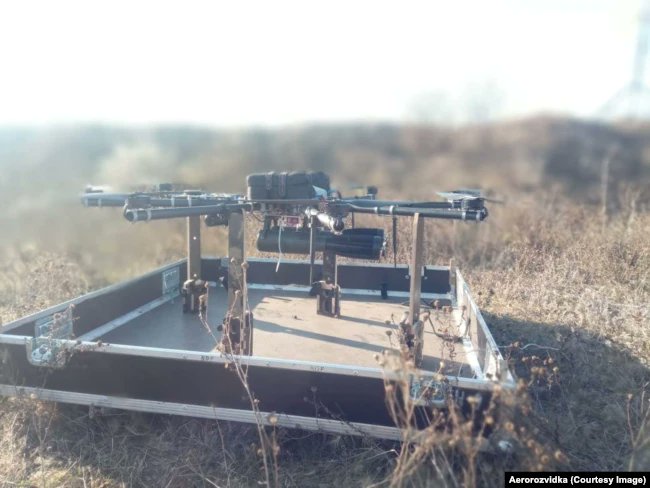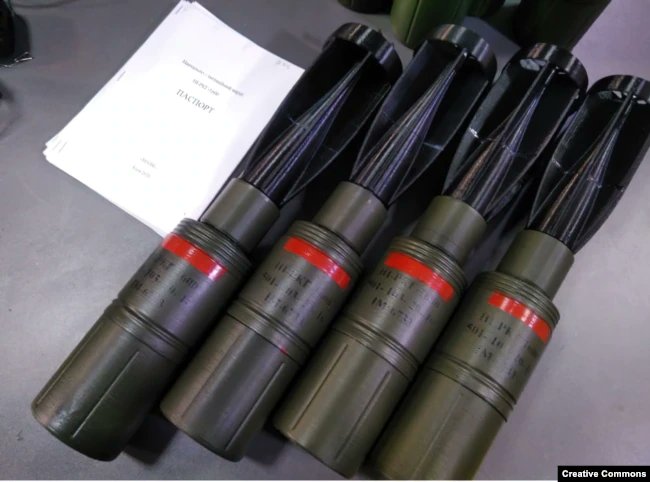Ukrainian fighters have found a new use for outdated grenades that is proving spectacularly effective at destroying Russian tanks and other armored vehicles.

This photo released by Aerorozvidka, an organization that develops Ukraine's use of small drones in warfare, shows a Ukrainian-made octocopter drone with two bomblets mounted beneath it.
Videos recently released by Aerorozvidka show what appears to be the same, tail-finned explosives being dropped by drone before destroying armored vehicles with catastrophic explosions.
Weapons trackers following the conflict in Ukraine have identified the bomblets as modified Soviet-era RKG-3 anti-tank grenades with 3D-printed tail fins attached to stabilize their fall from drones.


The RKG-3 (pictured) is an anti-tank grenade designed in the Soviet Union that was first introduced in 1950. The weapon is the size and weight of a slender bottle of wine and made to be thrown by hand at enemy armored vehicles.
The grenade contains a drogue parachute (visible at right inside this museum cutout), that springs out when thrown to ensure the grenade hits the target fuze-first.
On impact, the RKG-3 detonates a shaped charge (demonstrated in yellow in this cutout) that fires a hypersonic slug of copper with enough force to penetrate more than 20 centimeters of armor.
The burst of superheated metal into the interior of tanks can sometimes lead to "catastrophic" explosions of the ammunition inside.

Although remarkably effective on impact, the RKG-3 required near-suicidal proximity to enemy vehicles, and when rocket-propelled Soviet anti-tank weapons such as the RPG-7 entered service in the 1960s, fighters were able to hit enemy armor from hundreds of meters away. The risky, hand-thrown RKG-3 became largely obsolete.

A rare photo shows a Chechen fighter armed with an RKG-3 grenade in the center of Grozny during the first Chechen war in 1995.
Despite the grenade being the focus of a famous scene in the 2014 movie American Sniper, the RKG-3 has only rarely been seen in recent conflicts.
The weapon last hit the news in 2006 when they were shown in use by Al-Qaeda militants against U.S. armor in Iraq -- attacks that highlighted the weapon's collateral risks.
Although Russian forces have the technology for jamming drone controls, videos released by Aerorozvidka show that in several cases, drone pilots have been able to destroy vehicles worth at least hundreds of thousands of dollars with explosives that are estimated to cost less than $100.
The new development in low-cost drone warfare may pose an increasing problem for Russian armor parked anywhere near Ukrainian positions.
Video of bombs detonating IFVs

 www.rferl.org
www.rferl.org
@Nilgiri @Cabatli_53 @MisterLike @OPTIMUS @T-123456 @Captain_Azeri_76 @Fuzuli NL @Blackbeardsgoldfish @what @Yasar @Oryx @neosinan @Stimpy75 @Stuka @Anmdt
Dont miss it guys

This photo released by Aerorozvidka, an organization that develops Ukraine's use of small drones in warfare, shows a Ukrainian-made octocopter drone with two bomblets mounted beneath it.
Videos recently released by Aerorozvidka show what appears to be the same, tail-finned explosives being dropped by drone before destroying armored vehicles with catastrophic explosions.
Weapons trackers following the conflict in Ukraine have identified the bomblets as modified Soviet-era RKG-3 anti-tank grenades with 3D-printed tail fins attached to stabilize their fall from drones.


The RKG-3 (pictured) is an anti-tank grenade designed in the Soviet Union that was first introduced in 1950. The weapon is the size and weight of a slender bottle of wine and made to be thrown by hand at enemy armored vehicles.
The grenade contains a drogue parachute (visible at right inside this museum cutout), that springs out when thrown to ensure the grenade hits the target fuze-first.
On impact, the RKG-3 detonates a shaped charge (demonstrated in yellow in this cutout) that fires a hypersonic slug of copper with enough force to penetrate more than 20 centimeters of armor.
The burst of superheated metal into the interior of tanks can sometimes lead to "catastrophic" explosions of the ammunition inside.

Although remarkably effective on impact, the RKG-3 required near-suicidal proximity to enemy vehicles, and when rocket-propelled Soviet anti-tank weapons such as the RPG-7 entered service in the 1960s, fighters were able to hit enemy armor from hundreds of meters away. The risky, hand-thrown RKG-3 became largely obsolete.

A rare photo shows a Chechen fighter armed with an RKG-3 grenade in the center of Grozny during the first Chechen war in 1995.
Despite the grenade being the focus of a famous scene in the 2014 movie American Sniper, the RKG-3 has only rarely been seen in recent conflicts.
The weapon last hit the news in 2006 when they were shown in use by Al-Qaeda militants against U.S. armor in Iraq -- attacks that highlighted the weapon's collateral risks.
Although Russian forces have the technology for jamming drone controls, videos released by Aerorozvidka show that in several cases, drone pilots have been able to destroy vehicles worth at least hundreds of thousands of dollars with explosives that are estimated to cost less than $100.
The new development in low-cost drone warfare may pose an increasing problem for Russian armor parked anywhere near Ukrainian positions.
Video of bombs detonating IFVs

How Ukraine Uses Obsolete Soviet Grenades To Destroy Russian Tanks From Above
A cheap Soviet weapon has been adapted to drone warfare to destroy valuable Russian armor.
@Nilgiri @Cabatli_53 @MisterLike @OPTIMUS @T-123456 @Captain_Azeri_76 @Fuzuli NL @Blackbeardsgoldfish @what @Yasar @Oryx @neosinan @Stimpy75 @Stuka @Anmdt
Dont miss it guys







